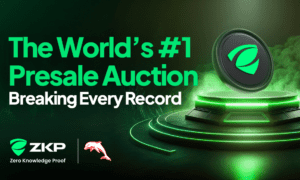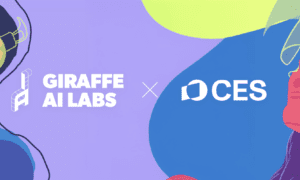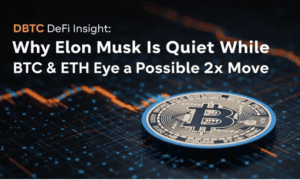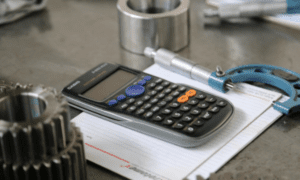How do you feel about uranium? If it’s a question you’ve never had pause to ponder, you’ve clearly never worked in the energy sector – or traded RWAs. While applications for uranium extend further than this, its primary use case remains as the fuel for nuclear reactors, whose virtually unlimited power supplies the world’s insatiable energy appetite.
The concerted push for environmental sustainability in all domains has transformed uranium into a critical commodity. With nuclear energy back in vogue as a zero-emission solution capable of meeting escalating demands, exacerbated by AI and data center growth, it’s spawned a thriving secondary market for uranium trading. While uranium markets aren’t new, they’re seeing renewed interest thanks to uranium’s second coming as Fuel of the Future coupled with another technology whose star is also in the ascendancy – blockchain.
It’s All About U
Uranium – or U as it’s listed in the periodic table of elements, where it holds the atomic number 92 – isn’t the first metal that springs to mind when you envisage tokenized real-world assets (RWAs). That honor goes to gold. But gold has been available to crypto traders in various forms, including as stablecoin collateral, for years. Uranium is a newer addition, both to the elemental table and to the pantheon of tokenized RWAs.
It’s early days for onchain RWAs, although everyone from TradFi institutions to DeFi developers is bullish on their prospects – there’s talk of them becoming a multi-trillion-dollar market by 2030. In the here and now, the first platforms for tokenizing and trading RWAs are finding favor with early adopters, and uranium is already well represented.
For traders intent on getting exposure to U, and the upside enshrined in that single letter, which holds the key to the world’s energy needs, there are already several dedicated web3 platforms. First out the gates is Uranium.io, backed by the Tezos blockchain, which enables users to trade physical uranium – that is, U308.
A newer rival, Uranium Digital, has recently entered the fray, raising $6.1 million to build its own crypto-powered spot market. While both platforms aim to democratize uranium investment, Uranium.io holds distinct advantages rooted in its first-mover status, among other things. Both platforms, however, presage the shape of uranium trading to come.
A New Frontier for Tokenized Uranium
Uranium, the backbone of nuclear power, is seeing a demand surge. The World Nuclear Association projects a 28% increase in uranium demand by 2030, with a 51% jump forecast for 2031-2040, fueled by around 440 operating reactors worldwide and 58 more under construction.
Traditionally, investing in physical uranium has been a game for institutional players, with minimum lot sizes often exceeding $4 million and limited liquidity in over-the-counter (OTC) markets. Tokenization changes that, breaking down barriers by allowing fractional ownership via blockchain technology such as smart contracts.
Uranium.io’s xU3O8 token, built on Tezos, represents legal ownership of physically allocated uranium ore concentrate (yellowcake) that’s stored in secure vaults – cos no one wants to self-custody their own uranium. The smart contract underpinning xU308, based on the
ERC-4626 Vault standard, tracks ownership in ounces and enables seamless transfers through approved wallets.
Uranium Digital, meanwhile, promises a 24/7 institutional-grade trading platform with physical settlement, leaning on partnerships with Curzon Uranium and Chainlink for transparency. While both uranium trading platforms share a vision of accessibility, Uranium.io’s longer time in the market has given it a clear head start.
With high minimum purchase requirements of around $3.5M, accessing uranium’s growth potential amid the nuclear energy renaissance is limited.
Tokenized uranium solves this by offering physical uranium through tokenization of deposits held by Cameco, featuring 24/7 trading hours… pic.twitter.com/hAtnIfJtBw
— XU3O8 (@uranium_io) March 17, 2025
First for U
Uranium.io was among the earliest RWA platforms to tokenize uranium and is led by Tezos co-founder Arthur Breitman. With no minimum investment threshold, Uranium.io opens the door to retail investors to whom it would be fair to say the global uranium market has empirically been off-limits. Just as crypto exchanges now routinely provide proof of reserves, Uranium.io does something similar, ensuring real uranium backs every token.
Navigating the regulatory landscape for uranium – a highly controlled substance – is no small feat. This has obliged Uranium.io to prioritize compliance from the outset, establishing a legal structure that aligns with nuclear material regulations and securities laws. Its Tezos-based system ensures transparency and auditability, enabling Uranium.io to scale efficiently as tokenized RWAs grow market share.
Security Is Non-Negotiable
Security is paramount when dealing with a commodity as sensitive as uranium. Uranium.io employs top-tier custody solutions, storing its yellowcake in what it describes as “the most secure physical vault in the world.” This physical security, paired with blockchain’s immutability, ensures token holders have direct, verifiable ownership without the risks of mismanagement.
Insurance and transparent reserve audits further bolster confidence. Uranium Digital also emphasizes security, touting storage at industry-recognized facilities and Chainlink’s decentralized oracles for reserve verification.
Leadership matters in a field blending nuclear energy, finance, and blockchain. Uranium.io’s team brings a wealth of experience, its founders boasting backgrounds in energy markets and technology. This depth of knowledge has guided Uranium.io’s strategic vision, from its smart contract design to its partnerships with industry players. The first-of-its-kind platform on Tezos is proof that blockchain can be applied to anything – and that if it can be tokenized, onchain users will line up to trade it.
Uranium Heats Up
If you’re interested in uranium, you may know that the center of a uranium oxide pellet during nuclear fission reaches 1700ºC. And if you’ve ever traded the stuff, you’ll be well aware that the uranium market is rapidly heating up, driven by its primary buyer, the USA, which has 94 reactors to feed.
Within the context of tokenized RWAs, different platforms take different approaches to maintaining their price peg with the real-world asset itself. Uranium.io’s pricing aligns broadly with OTC spot markets via market makers, avoiding a formal peg, which offers flexibility.
Uranium Digital’s model, while promising real-time bid-ask pricing, lacks detailed public specifics on its pricing mechanism since the platform’s current status is “Coming Soon.”
The rise of tokenized uranium aligns with nuclear energy’s resurgence as a clean power source and web3’s role in democratizing asset ownership. Uranium.io has seized this moment, leveraging its first-mover status and experienced team to lead the charge. Uranium Digital, with its fresh funding and ambitious vision, has also now entered the ring, and there are signs that other RWA platforms are also looking to introduce U308 markets.
We can’t hold, smell, or taste it, but we can trade it. And for a growing number of onchain users, that’s the only exposure to uranium they need.
Source: Depositphotos





























